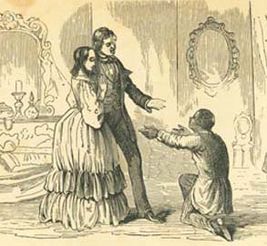Anti-Tom literature facts for kids

Anti-Tom literature was a group of books and other writings from the 1800s. These works were mostly written by authors from the Southern United States. They were created as a response to Uncle Tom's Cabin, a very popular novel by Harriet Beecher Stowe.
These "Anti-Tom" books, sometimes called plantation literature, tried to show slavery in a different light. They often argued that slavery was actually good for African Americans. They also claimed that the bad things about slavery shown in Stowe's book were exaggerated or not true.
Contents
Uncle Tom's Cabin and Its Impact
Uncle Tom's Cabin by Harriet Beecher Stowe was first released in parts from 1851 to 1852. It appeared in an abolitionist (anti-slavery) newspaper called The National Era. Then, in 1852, it was published as a full book.
This novel quickly became the best-selling novel of the 1800s. It was only outsold by the Bible that century. The book was written to highlight the terrible parts of slavery. It was inspired by the Fugitive Slave Act, a law passed two years earlier. This law made it a crime to help enslaved people who had escaped. Uncle Tom's Cabin was very controversial. It greatly increased the debate over slavery in the United States.
Authors Who Wrote Anti-Tom Books
Two of the most well-known Anti-Tom books are The Sword and the Distaff by William Gilmore Simms and The Planter's Northern Bride by Caroline Lee Hentz.
Simms' book, The Sword and the Distaff, came out just a few months after Stowe's novel. It included many parts that clearly argued against Stowe's ideas about slavery. This novel followed characters through the Revolutionary War and the time after it. Simms' book was popular enough that it was re-released in 1854 with a new title, Woodcraft.
The Planter's Northern Bride by Caroline Lee Hentz was published two years after Uncle Tom's Cabin. Hentz's book tried to defend slavery. It told the story through the eyes of a woman from the North. She was the daughter of an abolitionist, but she married a slave owner from the South. Like other books in this style, Hentz's novel tried to suggest that Black people needed white people's guidance to live well. Her book also talked about the fear of a slave rebellion. This fear was especially strong if abolitionists kept causing trouble.
Simms and Hentz's books were just two of about 20 to 30 pro-slavery novels written in the ten years after Uncle Tom's Cabin. Another famous author who wrote Anti-Tom novels was John Pendleton Kennedy.
Aunt Phillis's Cabin by Mary H. Eastman was one of the best-selling books in this group. It was published in 1852 and sold between 20,000 and 30,000 copies. In a note in her book, Eastman proudly mentioned that she was a descendant of the First Families of Virginia.
Little Eva: The Flower of the South, written by Philip J. Cozans, was a rare example. It was one of the few Anti-Tom books meant to be a children's novel.
Examples of Anti-Tom Novels
Here are some of the novels that belong to the Anti-Tom style:
- The Sword and the Distaff; or, "Fair, Fat and Forty": A Story of the South at the Close of the Revolution by William Gilmore Simms (1854)
- White Acre vs. Black Acre: A Case at Law by William M. Burwell (1856)
- Antifanaticism: A Tale of the South by Martha Haines Butt (1853)
- English Serfdom and American Slavery; or, Ourselves as Others See Us by Lucien B. Chase (1854)
- Ellen; or, The Fanatic's Daughter by Mrs. V.G. Cowdin (1860)
- Little Eva: The Flower of the South by Philip J. Cozans (1853)
- "Uncle Tom's Cabin" Contrasted with Buckingham Hall, the Planter's Home by Robert Criswell (1852)
- Aunt Phillis's Cabin: or, Southern Life As It Is by Mary H. Eastman (1852)
- The Ebony Idol: A Tale by Mrs. G.M. Flanders (1860)
- Liberia; or, Mr. Peyton's Experiments by Sarah Josepha Hale (1853)
- Frank Freeman's Barber Shop: A Tale by the Rev. Baynard R. Hall (1852)
- The Planter's Northern Bride by Caroline Lee Hentz (1854)
- Tit for Tat by "A Lady of New Orleans" (1856)
- The Lofty and the Lowly, or Good in All and None All Good by M. J. McIntosh (1853)
- Uncle Robin, in His Cabin in Virginia, and Tom Without One in Boston by J. W. Page (1853)
- The Cabin and Parlor; or, Slaves and Masters by Charles Jacobs Peterson (1852, under the name J. Thornton Randolph)
- The North and the South; or, Slavery and Its Contrasts: A Tale of Real Life by Caroline Rush (1852)
- The Black Gauntlet: A Tale of Plantation Life in South Carolina by Mary Howard Schoolcraft (1860)
- Life at the South; or, "Uncle Tom's Cabin" As It Is: Being Narratives, Scenes, and Incidents in the Real "Life of the Lowly" by W. L. G. Smith (1852)
- Mr. Frank, the Underground Mail-Agent by Vidi (1853)
- Life in the South: A Companion to Uncle Tom's Cabin by C. H. Wiley (1852)
- The Leopard's Spots, by Thomas Dixon Jr. (1901)
- The Clansman, by Thomas Dixon Jr. (1905)
See also
 In Spanish: Literatura anti-Tom para niños
In Spanish: Literatura anti-Tom para niños

